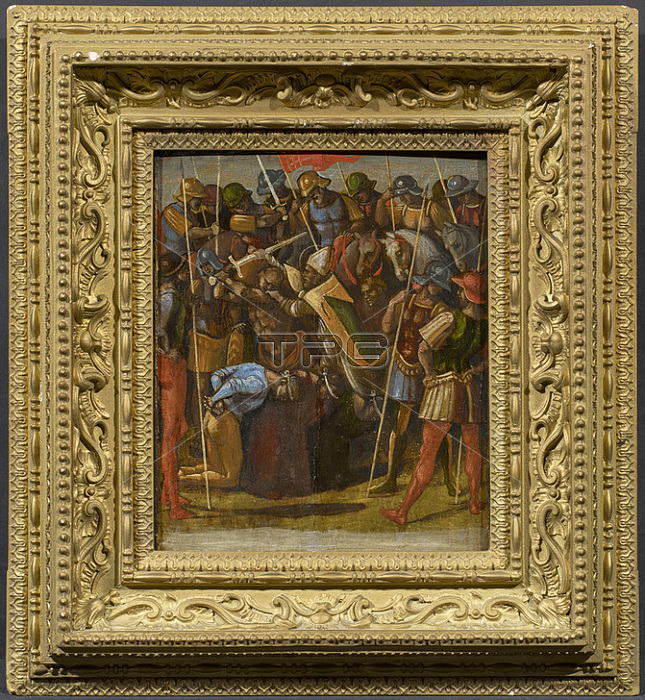
SIGNORELLI; LUCA
Cortona ca. 1450 - 1523
Nicholas of Beri Saves Three Knights from Execution.
Oil tempera on wood.
26;5 x 22;5cm.
Frame/Pedestal: Framed.
Certificate:
T.F.K. Henry; Kent; on 22.07.2020.
Provenance:
Church of San Niccol? Cortona;
Art market; Florence;
Collection Herzog Georg II. from Sachsen-Meiningen (1826-1914);
Family collection from Sachsen-Meiningen till 1947;
Private ownership; Germany.
Literature:
B. Berenson: The Central Italian Painters of the Renaissance; London and New York 1897; p. 180;
M. Cruttwell: Luca Signorelli; London 1899; p. 133;
G. Mancini: Vita di Luca Signorelli; Florence 1903; p. 182;
P. Lehfeldt und G. Voss: Bau- Und Kunst-Denkm鋖er Th黵ingens. HerzogtSachsen-Meiningen; Band XXI; 1984; p. 55;
L. Kanter: Some Late Altarpieces by Luca Signorelli. In: Studi di Storia dell'Arte; 2; 1991; p. 88-89;
T. Henry and L. B. Kanter: Luca Signorelli. The Complete Paintings; London 2002; p. 223-224; cat. 89;
T. Henry: The Life and Art of Luca Signorelli; New Haven and London 2012; p. 266-268.
Verso:
On the plate old handwritten inventory number.
"This important picture; which was last seen in the first half of the 20th century; is certainly by Luca Signorelli and formed part of an altarpiece that he painted for the church of S. Niccol?in Cortona; c.1508-10. The altarpiece survives in situ; and two related fragments of very similar dimensions to the present picture survive in the High Museof Art; Atlanta (K494 and K499).
It represents a legend from the life of Saint Nicholas of Bari; Bishop of Myra (270-343); e.g. in the Golden Legend of Jacobus de Voragine (1275). Three knights had been led to a place of execution and blind-folded; when the saint interceded; grabbing the executioner's sword and throwing it away (Voragine: "they were come to where they should be beheaded; he found them on their knees; and blindfold; and the executioner brandished his sword over their heads. Then S. Nicholas embraced with the love of God; set himself against the executioner; and took the sword out of his hand; and threw it from him; and unbound the innocents; and led them with him all safe.").
The picture was extensively described by Girolamo Mancini in 1903: "Nel castello di Meiningen S. A. R. Giorgio di Saxe-Meiningen conserva un frammento di gradino alto M.i 0;265 x 0;22; ricordato dal Berenson ed acquistato in Firenze dal duca intelligente amatore delle arti italiane. Tre condannati genuflessi cogli occhi bendati attendono la morte per mano del carnefice armato di spada; la cui lama e' trattenuta dalla mano d'un santo vescovo in mitra e grande mantello. Assistono due alabardieri a destra; due a sinistra; ed indietro presso il vescovo nove soldati a cavallo. Tra il vescovo ed i cavalieri apparicsce una quarta figura che colla maggior paura attende il momento di perdere il capo'." No image of the picture has ever been published.
The picture can be conclusively connected with a double-sided panel which still stands on the high altar of the small oratory church of San Niccol?in Cortona. The confraternity of Saint Nicholas was founded in 1440 by Saint Bernardino; and was closely associated with the Observant Franciscans. There is unconfirmed evidence that Signorelli was a member of the confraternity; and he demonstrated a particular devotion to Saint Nicholas of Bari in the prologue to his will of 1504 and specified reversionary bequests to the church of S. Niccol?in this will and in his later will of 1514.
Signorelli's altarpiece measures 152 x 175 cm. and depicts the Lamentation of Saints Michael; Jerome; Nicholas; Francis; Dominic and a bearded Franciscan saint over the Body of Christ presented by three Angels on one face; and the Virgin and Child enthroned with Saints Peter and Paul on the other. The S. Niccol?altarpiece was said to have had a predella; and Kanter identified two panels that are clearly related to the current picture in the High Museof Art; Atlanta. These represent the Birth of Saint Nicholas and another Saint Nicholas (K494 and K499; both 25.1 x 20.3 cm.); and Kanter correctly related the present picture to this commission on the basis of Mancini's description. All three panels are strongly lit from the left and were probably designed to be seen below the Virgin and Child enthroned with Saints Peter and Paul (also lit from the left) not the Lamentation (which is lit from the right). A fourth panel is lost.
Although some old retouching and overpainting is evident the picture is in good condition for a work of the sixteenth century.
The reverse of the panel is inscribed (apparently in black paint): 'Rumohr'; '35'. As a result there is a temptation to assume that K. F. von Rumohr (1785-1843); author of the Italienische Forschungen (Frankfurt; 1827-31) was involved in the picture's acquisition; but at the present time this cannot be proved.
The work is typical of Signorelli's style in the first decade of the sixteenth century and of his attentive approach to narrative painting. Mancini's description is accurate; although when read again in the light of the text of the Golden Legend the figure that Mancini identifies as awaiting his own fate should instead be seen as another of the captors."
| px | px | dpi | = | cm | x | cm | = | MB |
Details
Creative#:
TOP28562425
Source:
達志影像
Authorization Type:
RM
Release Information:
須由TPG 完整授權
Model Release:
No
Property Release:
No
Right to Privacy:
No
Same folder images:

 Loading
Loading